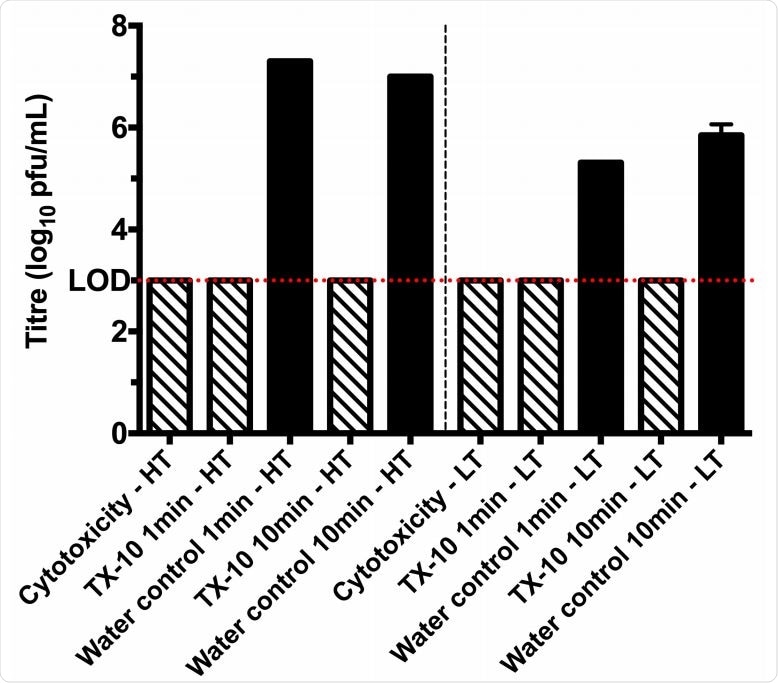The study demonstrated that Virusend TX-10 reduced titers of SARS-CoV-2 on surfaces and in solution to below the limit of detection within just one minute of contact.
Edward Patterson and colleagues say that ensuring disinfectants such as Virusend TX-10 are effective at inactivating SARS-CoV-2 is essential to eliminating environmental sources of the virus and reducing community transmission to help bring the pandemic under control.
Currently, mitigation strategies are focused on control measures such as social distancing and maintaining good hygiene standards in the home and in public places.
Patterson and team say the use of Virusend TX-10 could reduce reliance on the hygiene products currently used within private residences and communal public areas such as offices and hospitals.
“The development of disinfectants such as Virusend TX-10 and others is important as we continue efforts to reduce transmission of SARS-CoV-2,” writes the team.
A pre-print version of the paper is available on the bioRxiv* server, while the article undergoes peer review.

Virusend TX-10 reduces viral titer on hard surfaces by at least 4.0log10 PFU/mL with high titer (HT) viral inoculum after contact times of 1 minute and 10 minutes. When low titer (LT) inoculum was used, TX-10 reduces virus titer by at least a 2.31log10 PFU/mL at both 1 minute and 10-minute contact time. Diagonal pattern represents cytopathic effect caused by TX-10 and solid black represents the titer of infectious virus following each treatment. Limit of detection (LOD) (3.0log10 PFU/mL) is shown across the graph with a dotted red line.

 This news article was a review of a preliminary scientific report that had not undergone peer-review at the time of publication. Since its initial publication, the scientific report has now been peer reviewed and accepted for publication in a Scientific Journal. Links to the preliminary and peer-reviewed reports are available in the Sources section at the bottom of this article. View Sources
This news article was a review of a preliminary scientific report that had not undergone peer-review at the time of publication. Since its initial publication, the scientific report has now been peer reviewed and accepted for publication in a Scientific Journal. Links to the preliminary and peer-reviewed reports are available in the Sources section at the bottom of this article. View Sources
Potential reservoirs of indirect contact transmission
In the absence of any effective vaccine to protect against SARS-CoV-2, efforts to control transmission are limited to measures such as social distancing, restricted travel, hand hygiene and infection control in public places and households.
Studies have shown that SARS-CoV-2 can remain viable on surfaces such as stainless steel and plastic for up to 72 hours. In solutions such as respiratory droplets, the virus can remain infective for as long as 14 days at a temperature of 4°C , seven days at room temperature, and one to two days at 37°C.
Contaminated surfaces and solutions are, therefore, potential reservoirs of indirect contact transmission, the risk of which could be reduced through effective decontamination in communal and public places.
Disinfectants comprising 75% ethanol and 10% sodium hypochlorite have been shown to reduce SARS-CoV-2 titers by at least 2.0log10 PFU (plaque-forming units) per mL and 3.25log10 PFU/mL, respectively, within 5 minutes.
The world health organization (WHO) advises diluting household bleach at a ratio of 1:100 to reduce irritation and ensuring contact times of 10 to 60 minutes when decontaminating surfaces and when cleaning items.
What did the stud involve?
Patterson and the team used surface and solution inactivation and cytotoxicity assays to test the effectiveness of Virusend TX-10 at inactivating SARS-CoV-2.
On surfaces, Virusend TX-10 reduced both high and low titers of infectious SARS-CoV-2 to below the limit of detection within 1 minute.
The disinfectant reduced the high titer inoculum by at least 4.0log10 PFU/mL and the low titer by at least 2.3log10 PFU/mL.
Incubating a solution with Virusend TX-10 for one minute also reduced both high- and low-titer inoculum to below the limit of detection within one minute.
“Here we present the evidence that Virusend TX-10 can reduce SAR-CoV-2 virus within one minute both in solution and on surfaces,” writes the team.
An important step towards controlling the pandemic
The researchers say that ensuring disinfectants are highly effective against SARS-CoV-2 is an important step towards eliminating environmental sources of the virus and controlling the COVID-19 pandemic.
“Virusend TX-10 can reduce the strain of demand on current hygiene product resources,” they write.
The team says this disinfectant is “highly suitable” for rapidly decontaminating private households and public spaces such as hospitals and offices.
“The development of disinfectants such as Virusend TX-10 and others is important as we continue efforts to reduce transmission of SARS-CoV-2,” concludes the team.

 This news article was a review of a preliminary scientific report that had not undergone peer-review at the time of publication. Since its initial publication, the scientific report has now been peer reviewed and accepted for publication in a Scientific Journal. Links to the preliminary and peer-reviewed reports are available in the Sources section at the bottom of this article. View Sources
This news article was a review of a preliminary scientific report that had not undergone peer-review at the time of publication. Since its initial publication, the scientific report has now been peer reviewed and accepted for publication in a Scientific Journal. Links to the preliminary and peer-reviewed reports are available in the Sources section at the bottom of this article. View Sources